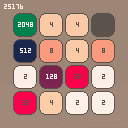

I created this to teach myself PICO-8. It has animations, and should be 100% accurate to the original game, including scoring (please let me know if this is not the case). All the 2048 versions I've found on the PICO-8 BBS don't have animations, or have different rules.
Since PICO-8 only supports 16-bit signed integers, it would only allow scores up to 32767, which is a problem with 2048 where scores can go much higher than that. I had to create a long integer "class" to fix that, which took a while. However, it still only supports scores up to just over 3 million. I decided that's probably enough.
Git Repo
Original game by Gabriele Cirulli
Update v1.0.2 (15/7/24):
- Add button buffering
- Add sound effects (optional)

Nice remake.
Controls wise, inputs are not buffered, so if I quickly press up then right, the right input is often not applied, especially on slower speed setting.
Another minor design mistake : when offering to reset the high score, the highlighted spot should be Cancel, not confirm, especially with X button auto-repeat, unless activating the confirm button requires a long press of both X and O at the same time, for example.
Had fun looking at your LongInt class, I'm not used to see OOP operator re-definition in pico-8 game.
Felt a bit overkill, as pico-8 numbers have 32 bits and you can do simple arithmetic to use the fractional part.
score+=100>>16 to add 100 to the score.
You can also multiply by an integer :
base=100>>16 multiplier_bonus=5 --not shifted score+=base*multiplier_bonus |
What you can't do is directly multiply two pre-shifted numbers
The only problem left is displaying the score.
@Felice made a great little converter function:
function getscoretext(val)
local s = ""
local v = abs(val)
while (v!=0) do
s = (v % 0x0.000a << 16)..s
v /= 10
end
if (val<0) s = "-"..s
return s
end |
If for some reason you need arbitrarily big integers, your OOP approach is nicer, but your internal data representation of the integer should be extendable, like an array or a string.

@RealShadowCaster Thanks for the feedback! Yeah making an entire class is probably overkill, but I had already written everything with normal numbers and I didn't want to have to go through and change everything. Plus it makes it more readable and I can reuse it in another game if I want to.
I didn't consider using the fractional part, that would've been much easier. I initially tried to do 2 16-bit numbers, but printing it would've been too hard. But using the fractional part, PICO-8 would mostly handle that for me. I might do that in a future game if I need it to be smaller.
Also yeah I plan to add buffered inputs (or cancel the animation when pressing the key) in a future version. And maybe add sounds.
[Please log in to post a comment]






